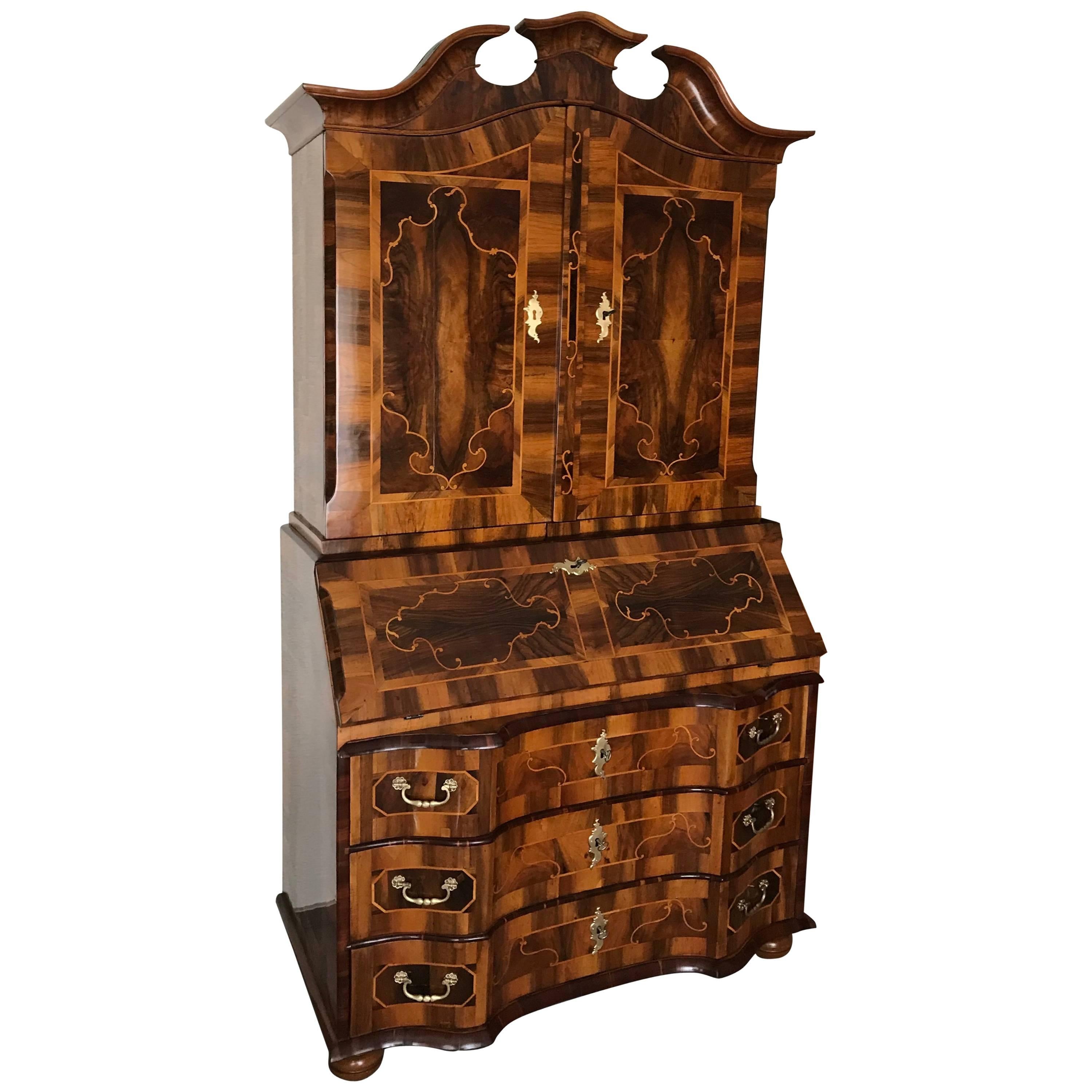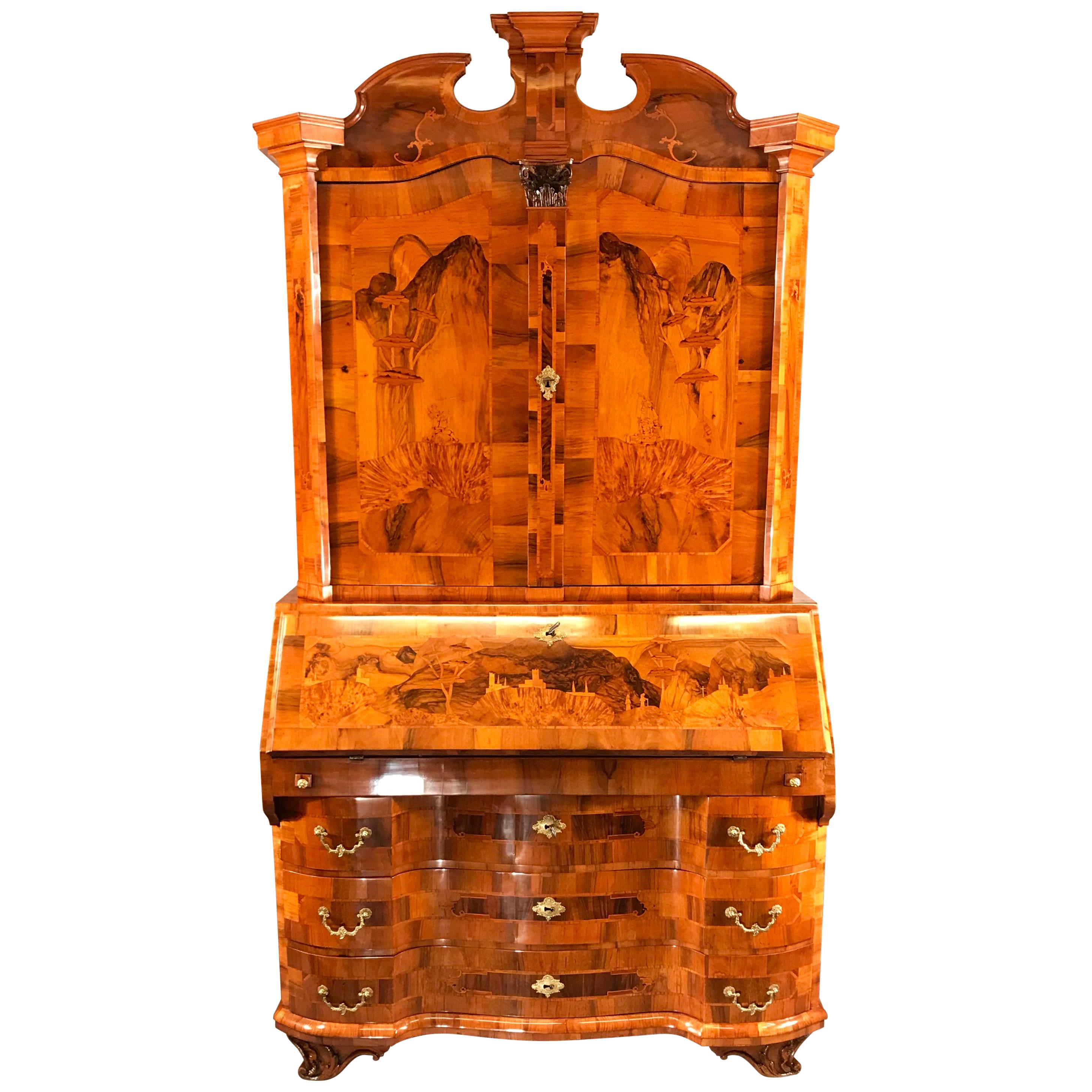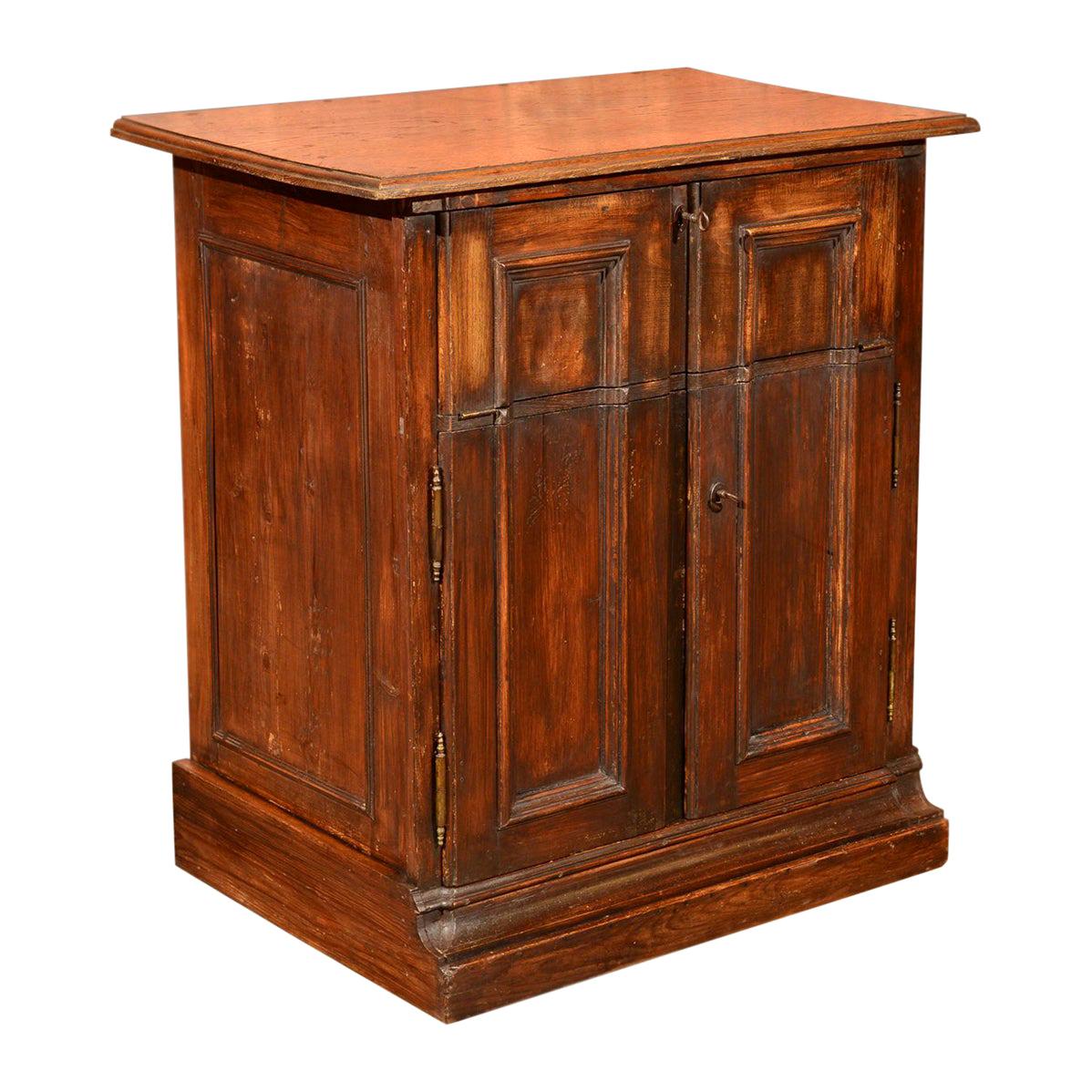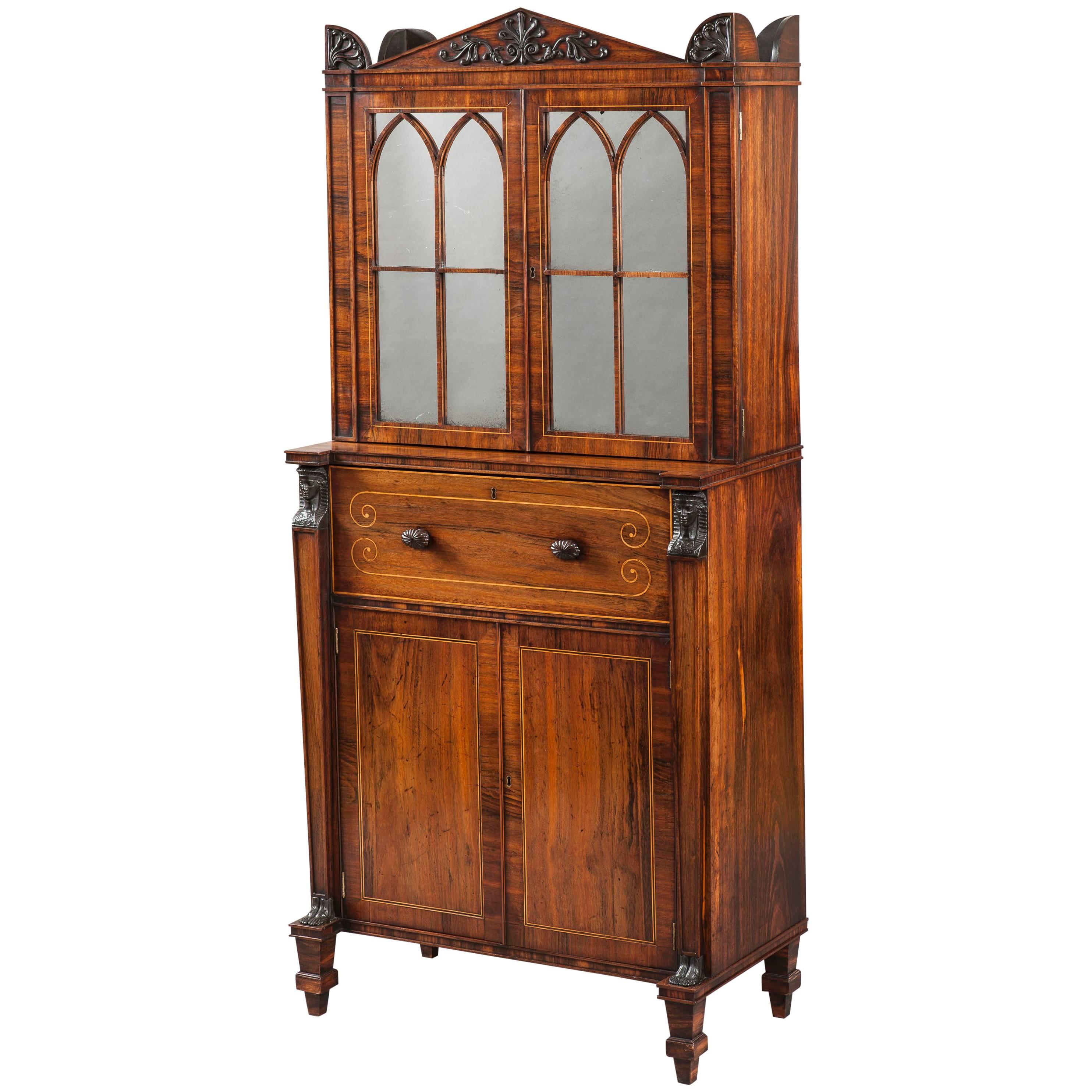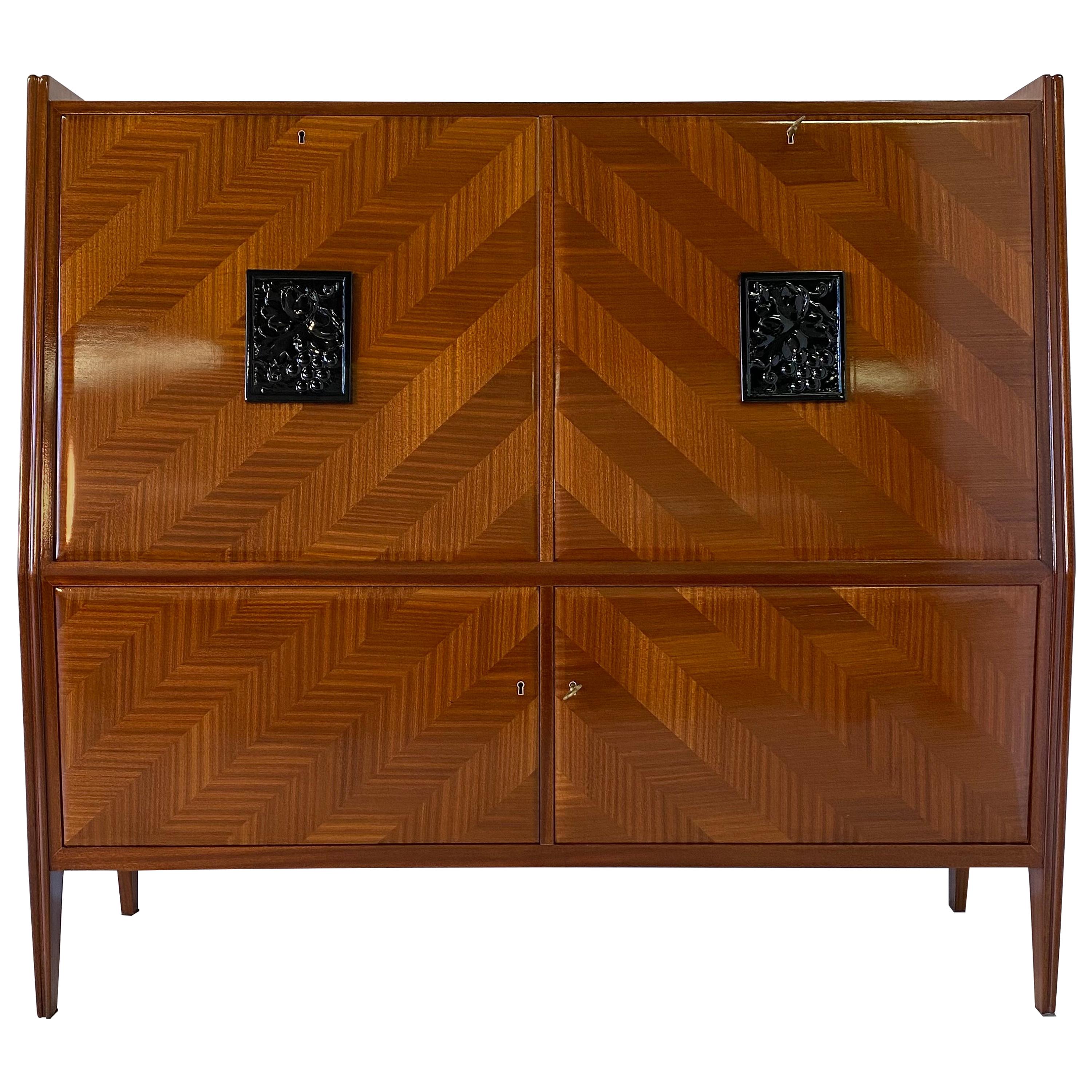Items Similar to Charles Spooner Arts & Crafts Oak secretaire Cabinet with Serpentine Stretchers
Want more images or videos?
Request additional images or videos from the seller
1 of 21
Charles Spooner Arts & Crafts Oak secretaire Cabinet with Serpentine Stretchers
About the Item
Charles Sydney Spooner, probably made by J H Brandt.
A rare oak secretaire cabinet on stand, with quarter veneered panels to the doors and drawers with black and green diamond shaped handles. The doors open to reveal adjustable shelves. The sides and lower stand are all made from solid quarter sawn oak with beautiful figuring. The slightly graduated mouldings to the waist frame the tidy little writing area. Standing on squashed ball feet, united with serpentine entwined stretchers.
This is an oak variation of the cabinet Charles Spooner exhibited at the Arts and Crafts Exhibition Society in 1910. One can see that both cabinets are essentially the same design, one with drawers one with a pull down writing area. Both have quartered veneered panels to the doors, the Mahogany one with applied moulded decoration to the doors.
See : illustration below from : Arts and Crafts Furniture by John Andrews.
See also : Charles Spooner Arts and Crafts Architect, page 209 illustration 10:28.
: Fine Art Society for a Coromandel variation and Puritan Values : Important Furniture Page 1, for a larger four door lacquered panelled variation.
Charles Spooner is noted as one of the most influential people and also credited as one of the fathers of the Arts and Crafts Movement.
Born at St Mary's Hospital, Paddington (London), Spooner was the second of 5 children of Charles Spooner and Sarah Frances Trinder, who lived at Brook Green, Hammersmith. Spooner became an architect and an instructor of furniture design at the London County Council's Central School of Arts and Crafts. He was a pupil and then assistant of Sir A W Blomfield and in 1890 won the RIBA’s Soane Medallion (Proc RIBA). He specialised in smaller churches and houses turning out some beautiful and complete buildings. He was influenced by E W Godwin and contemporary American architects such as H H Richardson. He was a member of the Society and Protection of Ancient Buildings and the Art Workers Guild, he worked in the tradition of William Morris, teaching furniture making and designing stained glass. These activities took up an increasing amount of his time in later life. His work was displayed at all the exhibitions of the Arts and Crafts Exhibition Society from 1890 to 1928, including an exhibition at the Grosvenor Gallery in January of 1913. He was also the secretary of the Woods Handicraft Society, and with Voysey exhibited significant pieces in The Arts & Crafts Exhibition Society show of 1890 and 1893. Spooner founded Elmdon and Co with his own workshops at 1 Ravenscroft Park in Hammersmith and held an exhibition at The Alpine Club in April 1905 not a stones throw from where William Morris famous Hammersmith rugs were made. He taught first at The Guild Of Handicraft and then at The Central School of Arts and Crafts and in 1908 was named by Ashbee alongside Lethaby, Gimson and Barnsley as one of the four most influential people with whom The Arts and Crafts Period is identified. Spooner's designs were also made by J.P.White whom also made furniture to the designs of M.H.Ballie Scott. Spooner was Lionised by Herman Muthesis in his very famous book 'Das Englishe Haus'.
Spooner was a work alcoholic, loved his work passionately to the point of excess. He was a very prolific designer & a true heavy weight of the period.
Tony Geering
- Creator:Charles Spooner (Designer)
- Dimensions:Height: 78 in (198.12 cm)Width: 39.5 in (100.33 cm)Depth: 16.75 in (42.55 cm)
- Style:Arts and Crafts (Of the Period)
- Materials and Techniques:
- Place of Origin:
- Period:
- Date of Manufacture:1920
- Condition:Wear consistent with age and use.
- Seller Location:London, GB
- Reference Number:
About the Seller
5.0
Vetted Seller
These experienced sellers undergo a comprehensive evaluation by our team of in-house experts.
Established in 1989
1stDibs seller since 2016
236 sales on 1stDibs
Typical response time: <1 hour
- ShippingRetrieving quote...Ships From: London, United Kingdom
- Return PolicyA return for this item may be initiated within 3 days of delivery.
More From This SellerView All
- Arts and Crafts Carved Oak Wall CabinetLocated in London, GBAn arts and crafts carved oak wall cabinet.Category
Early 20th Century Arts and Crafts Cabinets
MaterialsOak
- Shapland & Petter Arts & Crafts Oak Cabinet with Beaten Copper Handles & HingesBy Shapland & PetterLocated in London, GBShapland and Petter in the Liberty style. An Arts & Crafts oak music or storage cabinet with slightly angled sides. The top display area with stylized cut-out to the back and extend...Category
Antique Early 1900s English Arts and Crafts Cabinets
MaterialsCopper
- George Walton Style of a Small Arts & Crafts Oak Sideboard with Floral CarvingsBy George WaltonLocated in London, GBA small Arts & Crafts oak sideboard in the style of George Walton. With flaring cornice, four small upper cupboards the central pair with arched doors and a small work area in front...Category
Antique Early 1900s English Arts and Crafts Sideboards
MaterialsOak
- Arts & Crafts Oak Record Cabinet with Slide Out Drawers for Holding, 1978Located in London, GBA rare Arts & Crafts oak record cabinet for holding 1978 (LP's do not fit into this cabinet but singles do). With a roll up door retaining the original key ...Category
Antique Early 1900s English Arts and Crafts Cabinets
MaterialsOak
- An Arts and Crafts Oak and Chequer Inlaid Wall CabinetLocated in London, GBAn Arts and Crafts oak and chequer inlaid wall cabinet, possibly by Harris Lebus, with shelves and a door. Depth of shelves 6 1/4". Upper Shelf Hei...Category
Early 20th Century Arts and Crafts Cabinets
MaterialsOak
- E A Taylor for Wylie & Lochhead Arts & Crafts Display Cabinet with Heart DetailsBy E.A. Taylor 1, Wylie & LochheadLocated in London, GBE.A. Taylor made by Wylie and Lochhead. An Arts & Crafts mahogany display cabinet or sideboard, with upper open shelf and gallery with capped uprights to the sides, a central upper ...Category
Antique Early 1900s English Arts and Crafts Cabinets
MaterialsGlass, Mirror, Mahogany
You May Also Like
- Baroque Cabinet with Secretaire, Germany 1750Located in Belmont, MAStunning original baroque cabinet, Germany 1750. The cabinet originates from the area of the city of Brunswick. Walnut, plum wood and satinwood veneer. The cabinet will be directly s...Category
Antique 1750s German Baroque Cabinets
MaterialsWalnut
- Baroque Cabinet with Secretaire, Germany, 1750-1760Located in Belmont, MAOutstanding baroque cabinet with fall top secretaire, South Germany, 1750-1760. Beautiful walnut veneer with exquisite figural and landscape marque...Category
Antique 1750s German Baroque Cabinets
MaterialsElm, Walnut
- Antique Specimen Cabinet, French Oak Cupboard, Secretaire, Desk, circa 1850Located in Hele, Devon, GBThis is an antique specimen cabinet, a French, oak cupboard offering a secretaire desk dating to the late 19th century, circa 1850. In a de...Category
Antique Mid-19th Century French French Provincial Cabinets
MaterialsOak
- English Regency Period Secrétaire Cabinet with Egyptian MotifsBy George OakleyLocated in London, GBA secrétaire cabinet of the Regency period Firmly attributed to George Oakley. Constructed in a finely faded and patinated goncalo alvez, having holly and purple heart stringing;...Category
Antique 19th Century English Regency Cabinets
MaterialsPurpleheart, Satinwood, Holly
- King George I Ambassadorial Secrétaire-CabinetLocated in New Orleans, LAThis highly important secrétaire-cabinet was crafted for and specially ordered by King George I for the British Ambassador to Russia. From its craftsmanship and materials to its exceptional artistry, it is a work of royal and historic significance that exudes power in each and every detail. The broken pediment at its apex features the simplified royal coat of arms bearing the king’s crown, while the interior is adorned by portraits of the British Royal Family. Placed within the ambassador’s St. Petersburg home, this entirely unique piece of furniture would have been a potent reminder of England's grandeur and political importance. Relations between England and Russia during this period were at an all-time high. Peter the Great had traveled to England in 1698 as part of his widely known “Grand Embassy” tour, wherein he attempted to gain foreign support against the Ottoman Empire. He spent a period of nearly four months there, meeting with King William III and his court on numerous occasions. Noted academic Arthur MacGregor wrote concerning the impact of the trip, “For two decades following Peter's visit, British influence in Russia reached a peak. It manifested itself in social custom, in craft practice and in ships and naval organization... it reached a significant sector of the population before relations cooled once again and the two nations pulled back from this era of unprecedented cordiality.” First and foremost, however, it is a reminder of British might and influence. By the reign of King George I, England had come into its own as a world power. Unique in its design, this cabinet is a reflection of the country’s might. It is crafted from the highest-quality solid walnut and burr walnut adorned by gilded lock plates and engraved hinges. The presence of ormolu at its apex and lining the doors was a rarity for this period, and its addition makes manifest the importance of the design. The outer doors open to reveal multiple interiors, including fifteen separate drawers around a central cupboard; the cupboard doors each bear mezzotint portraits of George I and his father, Ernest Augustus, Elector of Hanover. An etching after the portrait of George I dating to circa 1716 is in London’s Royal Academy. A second, inner pair of doors are adorned by mezzotints of the Prince and Princess of Wales (later Queen Caroline and George II), which are both after portraits by Sir Godfrey Kneller dated 1716 in the Royal Collection. A final portrait is revealed on the very interior of the cabinet, where a mezzotint of Frederick, Anne, Amelia and Caroline, children of the Prince of Wales, resides. An etching (circa 1715-1720) after this portrait can be found in the National Portrait Gallery (London). Apart from its abundance of royal portraiture, the cabinet features stunning painted decoration, including floral designs as well as clouds, birds and trees in a bucolic motif reminiscent of Eden. Its lower portion is a study in both form and function, featuring a fitted secrétaire-drawer above three additional drawers for storage. The cabinet appears in The Shorter Dictionary of English Furniture by R. Edwards from 1964, a text that is regarded as the bible of British furniture design. Edwards describes it as a “writing cabinet...given by George I to the British Ambassador at the Russian court.” The cabinet was likely made for the 18th-century German diplomat and writer Friedrich Christian Weber, who represented English interests at the Russian court from 1714 until 1719. Although Weber’s tenure as ambassador was relatively short, while in St. Petersburg, he authored his account entitled Das veraenderte Russland (The Present State of Russia), which was published in three volumes in 1721, 1739 and 1740. It may, however, also have been made for George Douglas, 2nd Earl of Dumbarton, who served as ambassador alongside Weber in 1716. Diplomatic relations ceased between the two countries in 1721. In 1928, the cabinet appeared for sale at the International Exhibition of Antiques & Works of Art in Olympia. It had previously been in the collection of the Woltner family of Bordeaux, the celebrated vintners who owned the estate Château Laville Haut-Brion and produced wine of the same name. According to the family, Monsieur Woltner was given the cabinet as a gift from an aunt who lived in Russia for many years. After leaving the Woltner collection, the cabinet was acquired by William Berry...Category
Antique 18th Century English Georgian Secretaires
MaterialsBrass
- Italian Mahogany Secretaire Cabinet, 1950sLocated in Meda, MBPrecious cabinet secretaire produced in Italy in the 1950s, The whole cabinet is veneered in mahogany with a fine solid wood carving in the center of the two doors representing two b...Category
Vintage 1950s Italian Mid-Century Modern Cabinets
MaterialsMahogany, Maple
Recently Viewed
View AllMore Ways To Browse
Arts And Crafts Furniture
White Craft
Used Spoon
Spooner Glass
Glass Spoon
The Spoon
Spoon A
Arts Crafts Wood
Arts And Crafts Wood
Arts And Crafts Wood Furniture
Arts Crafts Oak
Arts And Crafts Oak Furniture
5 Spoons
Art1 And Craft
Black Diamond Pieces
Teaching Furniture
American Arts And Crafts Furniture
1920 Arts And Craft
